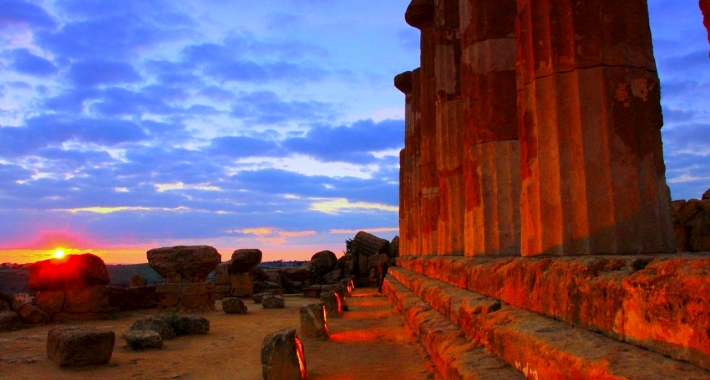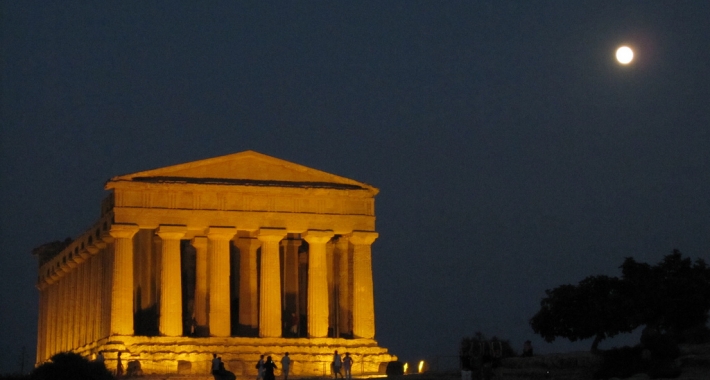Weekend in Agrigento
Agrigento is famous for its Valley of Temples, a remnant of majestic Ancient Greece

Photo by Stefano Liboni
Agrigento is mostly known for its splendid Valley of Temples, a grandiose testimony to mighty Ancient Greece. The historic city center also shares this beauty, holding many artistic and culturally significant churches, museums and religious structures.
Your visit into the city should probably start with the Abbazia di Santo Spirito, built in 1260, and one of the best preserved cloisters in Sicilian history. There’s much more to see; the Church of San Lorenzo made in a Renaissance-Baroque style, the Ipogei, 5th century underground aqueducts, which are surprisingly well preserved, and the Norman Cathedral with an unfinished bell tower.
With all these things to see, it’s best not to forget to visit the Hellenistic Roman District of Agrigento where you can admire the remains of patricians’ villas, with their spectacular mosaics, in the S. Nicola site. This site was excavated in the 50’s, rediscovering the urban life of ancient Akragas from the 3rd to the 5th century A.D. which extends in 10 square kilometers. Shops, taverns, aqueducts, and dozens of houses have been unearthed, some built in Greek style and others in Pompei style. Most notable are the Houses of the Maestro Astrattista, the House of Peristilio, and the Mosaic and Swastika structures.
The Valley of Temples is a perfect place to spend an atmospheric weekend; it’s a UNESCO World Heritage Site and an excellent example of Ancient Greece’s connections with Sicily. It’s the largest archeological site in the world; 1300 hectares of Doric temples, three sanctuaries, the Necropoli of Montelusa, Mosè, and Pezzino, plus a Roman one and Terone’s Tomb, besides a Paleochristian site and Acrosoli.
Your visit into the city should probably start with the Abbazia di Santo Spirito, built in 1260, and one of the best preserved cloisters in Sicilian history. There’s much more to see; the Church of San Lorenzo made in a Renaissance-Baroque style, the Ipogei, 5th century underground aqueducts, which are surprisingly well preserved, and the Norman Cathedral with an unfinished bell tower.
With all these things to see, it’s best not to forget to visit the Hellenistic Roman District of Agrigento where you can admire the remains of patricians’ villas, with their spectacular mosaics, in the S. Nicola site. This site was excavated in the 50’s, rediscovering the urban life of ancient Akragas from the 3rd to the 5th century A.D. which extends in 10 square kilometers. Shops, taverns, aqueducts, and dozens of houses have been unearthed, some built in Greek style and others in Pompei style. Most notable are the Houses of the Maestro Astrattista, the House of Peristilio, and the Mosaic and Swastika structures.
The Valley of Temples is a perfect place to spend an atmospheric weekend; it’s a UNESCO World Heritage Site and an excellent example of Ancient Greece’s connections with Sicily. It’s the largest archeological site in the world; 1300 hectares of Doric temples, three sanctuaries, the Necropoli of Montelusa, Mosè, and Pezzino, plus a Roman one and Terone’s Tomb, besides a Paleochristian site and Acrosoli.
The Temple of Harmony is the epitome of Ancient Greek cultural magnificence

Photo by Daniele Trotta
There are Ipogei and hydraulic works here too, such as the garden of Kolymbetra, the upper and lower Agorà, an Olympeion and a council chamber (Bouleuterion). The Temple of Harmony, which is built over 800 square meters, is a prime example of the magnificence and luxury of Ancient Greek culture. The Temple is so well preserved that it truly gives visitors the impression of traveling back in time, a uniquely emotional experience.
The Temple of Juno is situated on the highest hill of the Valley, and has been renovated multiple times. All of the Temples are worth the visit before returning to the city, where you can walk the same streets that Luigi Pirandello did in his youth. His house can be found in a small countryside village called “Caos”, only a few kilometers from the city and surrounded by olive trees, right along the coast. It’s a 17th century house that the Pirandello family moved into in 1867, and it’s where the great writer was born. Now it’s a national monument where Luigi Pirandello’s urn is kept, along with photographs, reviews of the first editions of his books, paintings, and theatrical work.
The Temple of Juno is situated on the highest hill of the Valley, and has been renovated multiple times. All of the Temples are worth the visit before returning to the city, where you can walk the same streets that Luigi Pirandello did in his youth. His house can be found in a small countryside village called “Caos”, only a few kilometers from the city and surrounded by olive trees, right along the coast. It’s a 17th century house that the Pirandello family moved into in 1867, and it’s where the great writer was born. Now it’s a national monument where Luigi Pirandello’s urn is kept, along with photographs, reviews of the first editions of his books, paintings, and theatrical work.
Written by:
Aldo Galvagno
Translation by: Daniel Yeatman


